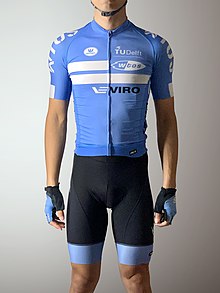This article has multiple issues. Please help improve it or discuss these issues on the talk page. (Learn how and when to remove these messages)
|
Compression garments are pieces of clothing that fit tightly around the skin. In medical contexts, compression garments provide support for people who have to stand for long periods or have poor circulation. These come in varying degrees of compression, and higher degree compression sleeves, such as sleeves that provide compression of 20–30 mmHg or higher, typically require a doctor's prescription.[1] Compression garments worn on the legs can help prevent deep vein thrombosis and reduce swelling, especially while traveling.

Compression can also be used for post surgeries, to help with the healing process. Garment usage varies per patient but can be worn up to a year. There is also second stage compression garments, that are every day wear.
In sports, form-fitting compression sportswear, usually made of spandex, is commonly worn by athletes and in exercise to prevent chafing and rashes.
Maternity wear
editA bellyband, wrap, or abdominal binder is a compression garment which resembles a tubetop but worn over the abdomen of expectant mothers.[2] Bellybands are also commonly worn post-childbirth to help provide abdominal and back support thereby making it easier to perform day to day tasks, and to help mothers with their posture.
Compression stockings and socks
editCompression stockings and socks is hosiery specifically designed to help prevent the occurrence of various medical disorders relating to blood circulation in the legs. They can also be used to halt the progression of these disorders.
Compression gloves
editCompression gloves are handwear designed to help prevent the occurrence of various medical disorders relating to blood circulation in the wrists and hands. They can be used to treat the symptoms of arthritis,[3] though the medical benefits may be limited.[4]
Sportswear
editCompression sportswear (shirts, shorts, sleeves, socks or underwear) is usually worn by athletes who wish to enhance performance or recovery speed. Garments are form-fitting garments often made from a spandex-type material.
Depending on the material used and the requirements of the sport, compression garments can be designed to keep athletes cool or warm. For example, speedskaters can wear compression bodysuits on the cold rink, while beach volleyball players can wear a similar-looking suit made of a more breathable, lightweight blend. Both use moisture wicking materials like nylon and spandex in order to keep the garment lightweight. Additionally, speed skaters can use the aerodynamic nature of wearing a skintight suit to their advantage, while a beach volleyball player has the added benefit of SPF 50+ garments to keep them protected during sunny days.[5] The athletes pictured show some alleged benefits that make compression garments popular in a wide range of sports and different designs.
Performance
editAlthough there are strong claims that compression garments could improve sports performance, methodological approaches and the direction of evidence regarding garments for use in high-intensity exercise settings are diverse and in certain scenarios do not show clear positive evidence.[6]
The conclusion of this 2018 meta-analysis showed that lower-limb compression garments were not associated with improved running performance, vertical jump, VO2max, VO2submax, lactate concentration, or rating of perceived exertion during high-intensity exercise.
Shorts and tights
editCompression shorts and tights are usually worn by athletes. They are form-fitting garments and cover the wearer's waist to mid or lower thigh, similar to cycling shorts. They are referred to as spats in Japan and safety shorts in South Korea.
Many are available with a cup pocket, a sewn-in pocket that can hold a protective cup. It is arguable that compression shorts do not keep cups in the proper position, tight to the body and not moving, as a jockstrap can. Some male players wear the compression shorts over the traditional jockstrap.[7][failed verification]
Compression shorts are also popular among female athletes, especially amongst those who wear skirts or kilts during games. In those situations, athletes wear compression shorts under the skirt so if they fall over and their skirts ride up, their underwear will not be exposed. This is seen particularly in women's lacrosse and field hockey (both being limited contact sports in which players often wear skirts). Women also wear compression shorts in tennis, where, most recently, compression shorts have been produced with ball pockets for convenience.[8]
See also
editReferences
edit- ^ "Seattle Cancer Care Alliance". seattlecca.org. 2016. Retrieved 2016-12-12.
- ^ Curtis, Glade B.; et al. (2016), Your Pregnancy: Week by Week, 8th ed., Da Capo Press, p. 414.
- ^ Hammond, Alison; Prior, Yeliz (1 March 2021). "Compression gloves for patients with hand arthritis (C-GLOVES): A feasibility study". Hand Therapy. 26 (1): 26–37. doi:10.1177/1758998320986829. ISSN 1758-9983. PMC 10584057. PMID 37905193. S2CID 232050521.
- ^ Hammond, Alison; Jones, Vivienne; Prior, Yeliz (1 March 2016). "The effects of compression gloves on hand symptoms and hand function in rheumatoid arthritis and hand osteoarthritis: a systematic review". Clinical Rehabilitation. 30 (3): 213–224. doi:10.1177/0269215515578296. ISSN 0269-2155. PMID 25802424. S2CID 40742720.
- ^ "The compression clothing phenomenon - Women's Health & Fitness". www.womenshealthandfitness.com.au. Retrieved 2017-05-30.
- ^ da Silva, César Augusto; Helal, Lucas; da Silva, Roberto Pacheco; Belli, Karlyse Claudino; Umpierre, Daniel; Stein, Ricardo (August 2018). "Association of Lower Limb Compression Garments During High-Intensity Exercise with Performance and Physiological Responses: A Systematic Review and Meta-analysis". Sports Medicine (Auckland, N.Z.). 48 (8): 1859–1873. doi:10.1007/s40279-018-0927-z. ISSN 1179-2035. PMID 29721839. S2CID 19219548.
- ^ "Where have all the jockstraps gone?". Slate Magazine (2005-07-22). 2005-07-22.
- ^ "How Compression Gear Enhances Performance in Sports: A Game-Changing Edge". Robbins Athletics. 2 August 2024.
